Hammock camping is an increasingly popular way to experience the great outdoors. It offers a lightweight and comfortable alternative to traditional tent camping. Whether you’re looking to relax in the woods, enjoy a scenic view, or spend the night under a blanket of stars, hammock camping can provide a unique and enjoyable experience. For beginners, however, getting started can feel overwhelming. In this article, we will explore essential tips for beginners to embark on their hammock camping journey.
Benefits of Hammock Camping
Hammock camping offers unique advantages, making it a popular choice among outdoor enthusiasts. It combines practical features with comfort to enhance your camping experience.
Comfort and Relaxation
Hammocks provide exceptional comfort compared to sleeping on the ground. They reduce pressure points, allowing your body to relax completely. The gentle rocking motion can offer a soothing sleep experience. Relaxing in a hammock enables you to enjoy views while feeling supported and cozy.
Lightweight and Portable Setup
Hammocks are lighter than tents, making them easier to carry. Their compact design means they take up minimal space in your backpack. This feature is ideal for backpackers and hikers prioritizing convenience. A portable setup saves time and energy during trips, improving overall mobility.
Versatility in Various Environments
Hammocks can be set up in diverse terrains, as they rely on trees rather than flat ground. You can camp in rocky areas, muddy trails, or uneven forest floors without any issue. This versatility helps you explore more destinations and avoid crowded camping sites. Hammock camping adapts to a wide range of conditions, enhancing flexibility during outdoor adventures.
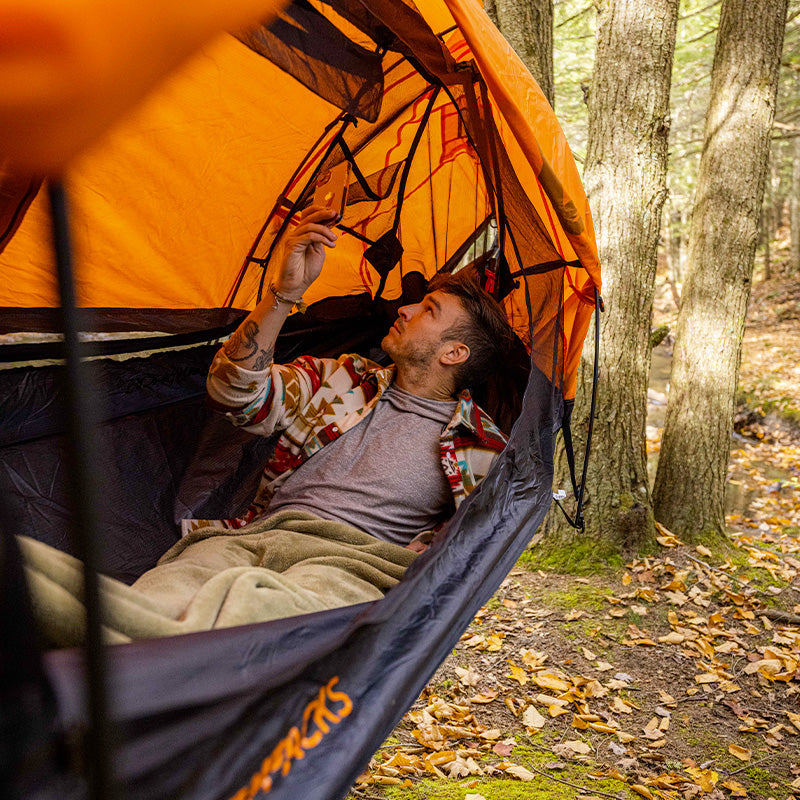
Choosing the Right Hammock
Selecting the perfect hammock is crucial for a successful camping experience. The right hammock ensures comfort, safety, and durability during your outdoor adventure.
Types of Hammocks for Camping
Camping hammocks come in various types to suit different needs. Single hammocks are compact and suitable for solo campers. They are lightweight and easy to carry. Double hammocks provide extra space, ideal for couples or those needing more room. They are slightly heavier but more versatile. Jungle hammocks include bug nets and rain tarps, perfect for camping in wet or insect-prone areas. They offer complete protection from the elements.
Material and Durability Considerations
The material of your hammock determines its comfort and longevity. Nylon hammocks are popular due to their strength and water resistance. They are lightweight and dry quickly. Polyester hammocks resist UV rays, making them durable under direct sunlight. Opt for materials with a high denier rating for added durability. Always check the stitching quality to ensure the hammock can endure outdoor conditions. Durable hammocks last longer and withstand rugged camping environments.
Weight Capacity and Size Guidelines
Weight capacity is a vital factor in hammock camping. Choose a hammock that can support your weight safely. Most hammocks have weight limits ranging from 200 to 500 pounds. Check the manufacturer’s specifications before purchase. Size is equally important. A standard hammock length of 9-11 feet suits most adults. Taller individuals may require longer hammocks. Wider hammocks offer more comfort, especially for side sleepers. Ensure your hammock fits your needs without adding unnecessary weight to your gear.
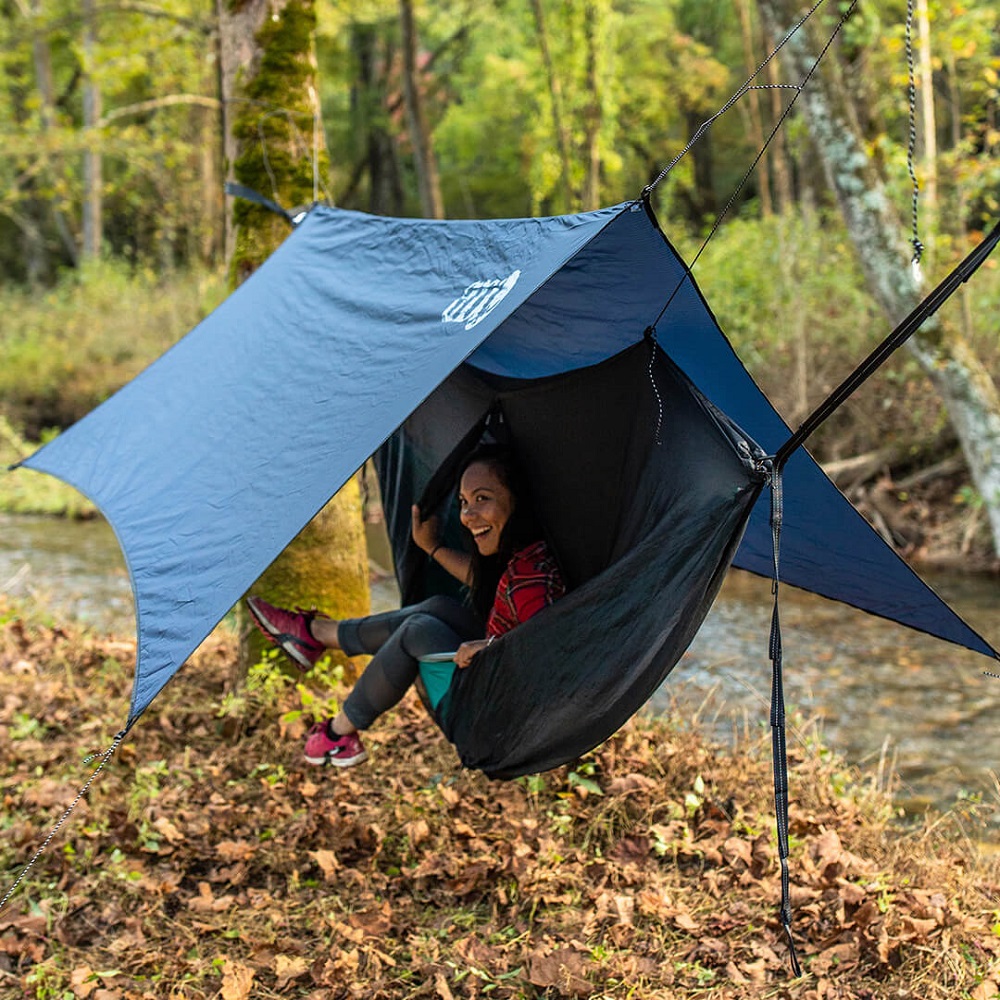
Essential Hammock Camping Gear
Having the right gear is essential for a successful hammock camping trip. Equip yourself with items that improve comfort, safety, and functionality during your outdoor adventure.
Suspension Systems and Straps
Suspension systems hold your hammock in place. Choose strong, adjustable straps to secure it safely. Look for tree-friendly straps that are wide enough to avoid damaging bark. Avoid ropes as they may harm trees and lack adjustability. Good suspension systems simplify setup while ensuring stability.
Bug Nets and Rain Tarps
Bug nets protect you from insects, especially in mosquito-prone areas. Ensure the net fits your hammock and provides full coverage. Rain tarps shield you from rain and wind. Choose waterproof tarps with reinforced corners for durability. Bug nets and rain tarps add comfort and protection during unpredictable weather conditions.
Sleeping Pads and Quilts
Sleeping pads provide insulation and cushioning. They keep you warm by reducing heat loss. Opt for lightweight and compact pads suitable for hammocks. Quilts offer better insulation compared to standard sleeping bags. Hammock-specific quilts are designed to wrap around your hammock, maximizing warmth. Both are essential for overnight comfort in cooler climates.
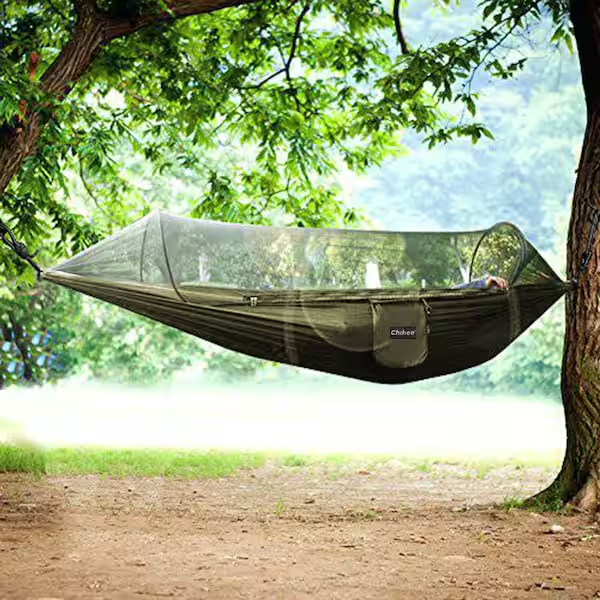
Finding the Perfect Campsite
Choosing the right campsite is critical for a successful hammock camping adventure. It ensures comfort, safety, and an enjoyable outdoor experience.
Selecting Trees for Hammock Setup
Choose sturdy trees spaced 10-15 feet apart for your hammock setup. Trees should be at least 6 inches in diameter to support your weight safely. Avoid dead or weak trees, as they may collapse. Look for healthy trees with no obvious signs of damage or rot. Check for overhead hazards like falling branches and make sure the area is clear.
Safety Tips for Location Choices
Avoid camping near water sources prone to flooding or attracting wildlife. Stay clear of low-lying areas where cold air tends to settle overnight. Look for flat ground beneath your hammock to prevent standing water. Keep your campsite away from trails or active animal paths to avoid disturbances. Always scout the area for hazards before unpacking.
Avoiding Environmental Impact
Use tree-friendly straps to prevent bark damage and protect natural habitats. Avoid trimming or altering trees for your setup—leave the area untouched. Avoid camping in areas with delicate vegetation or protected ecosystems. Pack out all trash and avoid leaving items behind. Responsible camping preserves nature for future enjoyment and minimizes ecological harm.
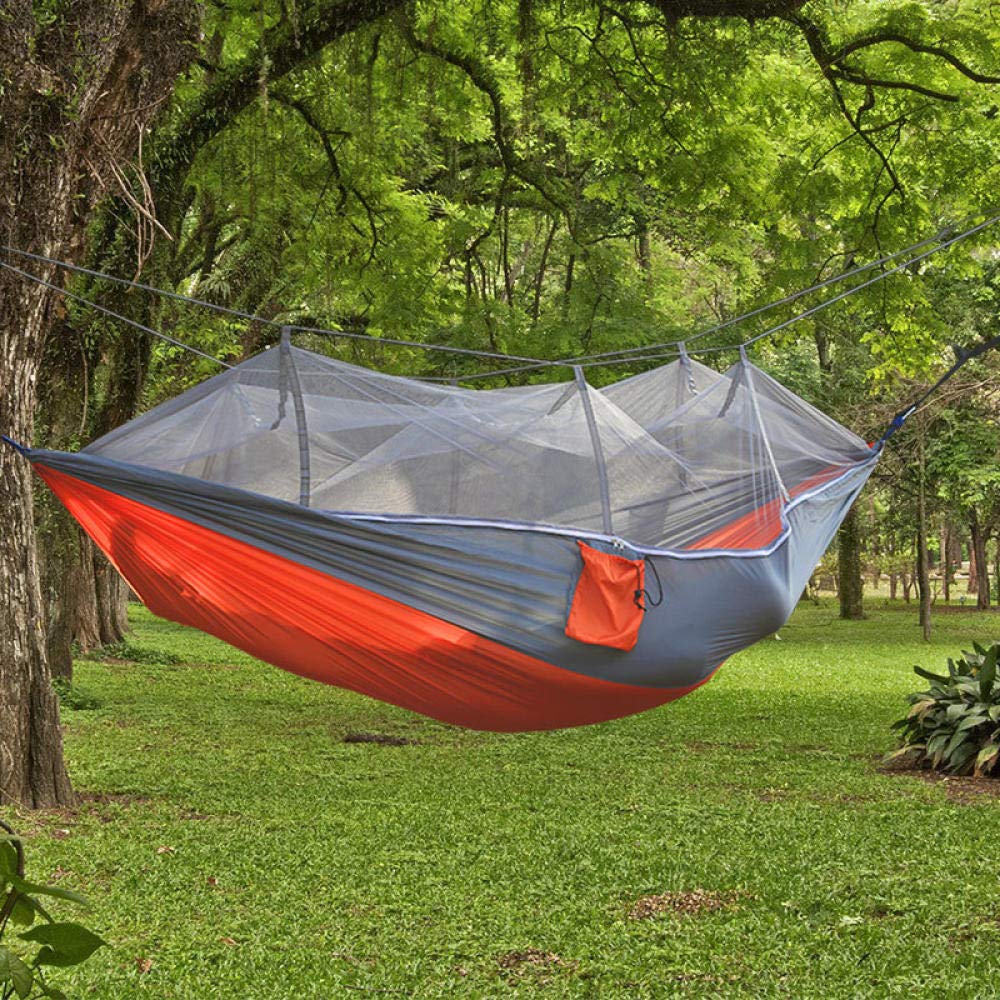
Setting Up Your Hammock Correctly
Setting up your hammock correctly ensures comfort and safety during your camping experience. A proper setup reduces stress on gear and ensures restful sleep. Follow best practices for hanging your hammock in a secure and enjoyable manner.
Proper Hanging Techniques
Use strong and adjustable straps for secure hammock suspension. Avoid using ropes, as they can harm trees and lack adjustability. Attach the straps at chest height, wrapping them snugly around the tree trunk. The straps should form a gentle arc when the hammock is in use. Check for solid tension and ensure the fabric spreads evenly to prevent slippage.
Ideal Hammock Height and Angle
Hang your hammock so the lowest point stands about 18 inches above the ground. This height prevents too much sag and keeps you safe from bugs or water hazards. Aim for a 30-degree angle between the suspension straps and the tree. This angle provides a comfortable balance and reduces strain on the fabric. Proper height and angle ensure stability and relaxation.
Tips for Adjusting for Comfort
Test your setup before fully committing to the position. Adjust the sag to support your back comfortably. Lie diagonally across the hammock for a flat sleeping surface. Bring extra straps for flexibility in different terrains. Check knots and attachment points frequently during your trip to maintain stability. Practical adjustments improve relaxation and overall enjoyment of hammock camping.
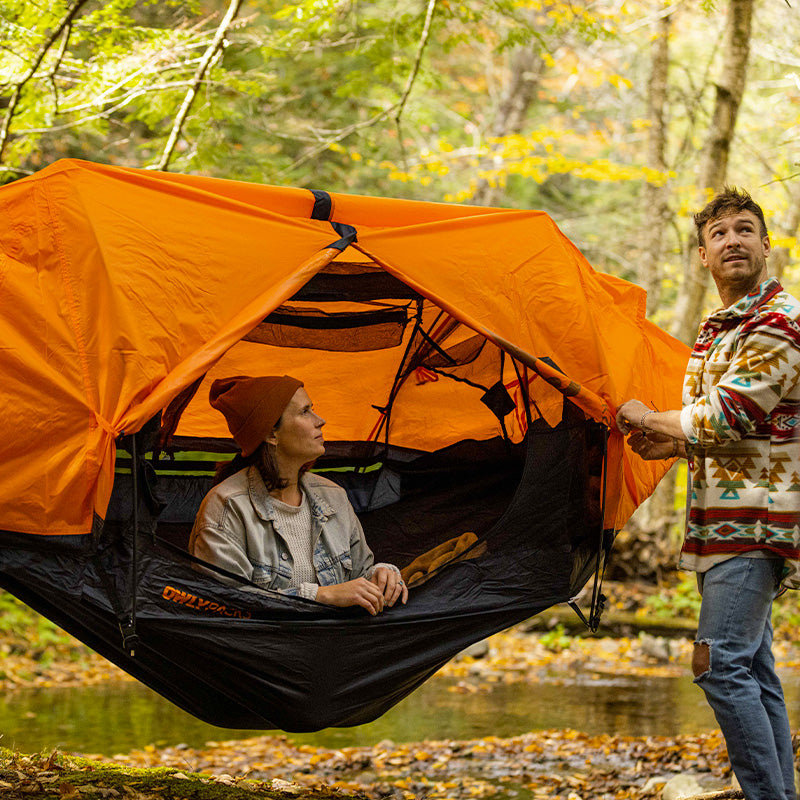
Staying Safe While Hammock Camping
Safety is critical when hammock camping. Proper planning ensures a secure and enjoyable experience. Prepare for unexpected challenges and prioritize protection from weather, wildlife, and cold.
Weather Precautions and Preparation
Check the weather forecast before your trip. Bring gear suited for rain, wind, or sun. Use waterproof rain tarps to shield your hammock from rain and moisture. Secure tarps with reinforced corners for durability during storms. Pack warm clothing layers to prepare for sudden temperature drops. Avoid camping during extreme weather conditions like heavy storms or high winds. Protect yourself and your equipment during unpredictable weather changes.
Wildlife Awareness and Protection
Choose a campsite away from animal trails or dens. Store food securely to avoid attracting wildlife. Use bear bags or animal-proof containers to keep food out of reach. Avoid wearing strong perfumes or scented toiletries that might lure animals. Keep noise levels low to avoid startling wildlife nearby. Always carry a flashlight or headlamp to stay alert in the dark. Awareness minimizes risks of unwanted encounters with animals.
Staying Warm in Cold Conditions
Pack insulation gear for colder climates. Use hammock-specific quilts to trap heat effectively. Sleeping pads add an extra layer of warmth beneath you. Bring thermal blankets for extra protection on freezing nights. Avoid body heat loss by wearing insulated clothing. Seal large tarps around your setup to block cold drafts. Staying warm ensures comfort and safety throughout chilly camping adventures.
Common Camping Mistakes to Avoid
Understanding common mistakes when hammock camping helps you improve your experience and prevent discomfort or accidents.
Hanging Too Tight or Too Loose
Avoid hanging the hammock too tight—it puts strain on the fabric and suspension. A tight setup reduces flexibility, making sleep uncomfortable. Hanging it too loose can cause sagging, risking lower back strain. Aim for a 30-degree angle between the straps and the anchor points. Test the hammock’s tension to ensure smooth and even support.
Ignoring Hammock Weight Limits
Always check the weight capacity of your hammock before use. Exceeding the limit may damage your gear and lead to accidents. Most hammocks support weights ranging from 200 to 500 pounds. Be mindful of added weight from sleeping pads, quilts, or gear inside the hammock. Follow manufacturer guidelines and choose hammocks that match your needs.
Setting Up in Hazardous Areas
Avoid areas with poor tree selection, such as dead or damaged trees. Weak trees can collapse under pressure, posing risks. Check the ground beneath your hammock for sharp objects, water, or uneven terrain. Stay clear of animal trails, flood zones, or areas with heavy winds. Scan for overhead hazards like falling branches before setting up. Select safe and stable campsite locations for maximum security and comfort.
Tips for a Comfortable Camping Experience
Maximizing comfort during hammock camping ensures an enjoyable and stress-free outdoor adventure. Here are key tips.
Packing Efficiently
Carry only essential items to avoid overloading your backpack. Prioritize lightweight and compact gear. Include high-quality suspension straps, a bug net, and a rain tarp. Pack insulation tools like sleeping pads and quilts for cold nights. Organize your items in categories for easy access. Use waterproof bags to protect your gear from unexpected rain.
Practicing Before Your Trip
Test your hammock setup at home or a nearby park. Practice attaching straps and adjusting angles. Learn to position your hammock for optimal back support and comfort. Experiment with gear placement inside the hammock to avoid clutter. Familiarize yourself with adjusting bug nets and rain tarps. Regular practice builds confidence and saves time during the trip.
Maintaining Your Hammock Gear
Clean your hammock after every camping trip to prevent wear and tear. Inspect straps for fraying or damage before reuse. Store your hammock in a dry, cool space to avoid mildew. Lubricate metal components in buckles or clips to maintain durability. Replace damaged parts immediately to ensure safety. Proper maintenance prolongs the life of your gear and supports a trouble-free experience.
Enjoying Your Hammock Camping Experience
Embrace Relaxation
Once you’ve set up your hammock, take the time to relax and enjoy your surroundings. Hammock camping allows you to unwind and disconnect from everyday life. Bring a book, listen to music, or simply soak in nature. Embracing relaxation is one of the greatest benefits of hammock camping, providing an opportunity to recharge both physically and mentally.
Engage in Activities
While relaxing in your hammock is enjoyable, there are also plenty of activities you can engage in during your trip. Consider exploring hiking trails, going fishing, or simply walking around to appreciate nature. Bring along games or art supplies for added fun. The versatility of your camping setup allows you to enjoy various outdoor pursuits, making your adventure more fulfilling.
Connecting with Fellow Campers
If you’re camping in a popular area, take advantage of the opportunity to meet fellow campers. Sharing experiences and tips can enhance your outdoor adventure. Many campers enjoy hammock setups, creating a community atmosphere. This camaraderie enriches your camping experience, making it memorable and enjoyable.
Conclusion
Hammock camping offers an exciting way to enjoy the great outdoors. With thoughtful preparation, the right gear, and a little know-how, you can experience the unique pleasures of sleeping under the stars. Choosing high-quality equipment begins with selecting the right hammock, suspension system, and accessories that suit your needs.
Embrace the advantages of hammock camping by taking the time to explore the world around you and engage in activities that enhance your experience. Pay attention to safety and maintenance, ensuring that your gear remains functional and comfortable for many adventures to come.
With these tips in mind, you are ready to embark on your hammock camping journey. So, set up your hammock, relax, and enjoy the beauty of nature while creating memories that will last a lifetime. Happy camping!
